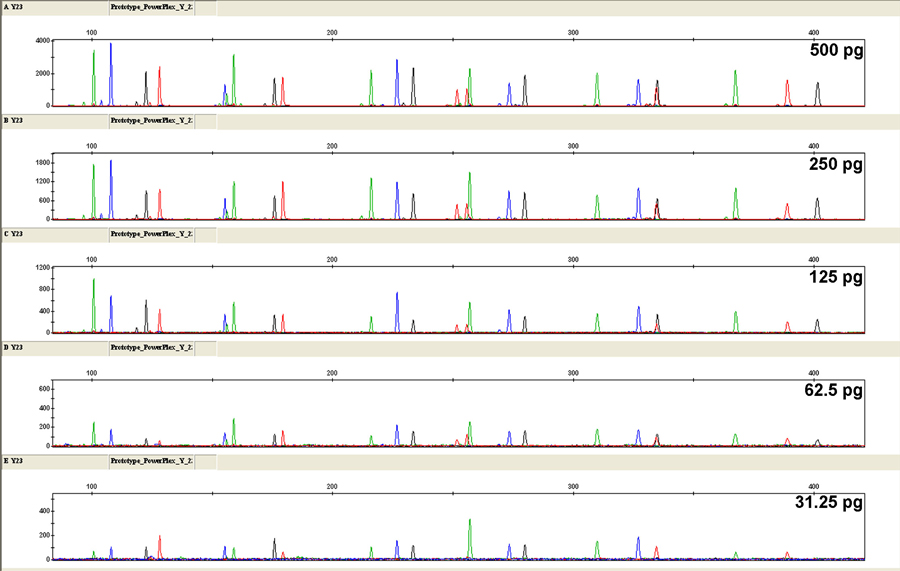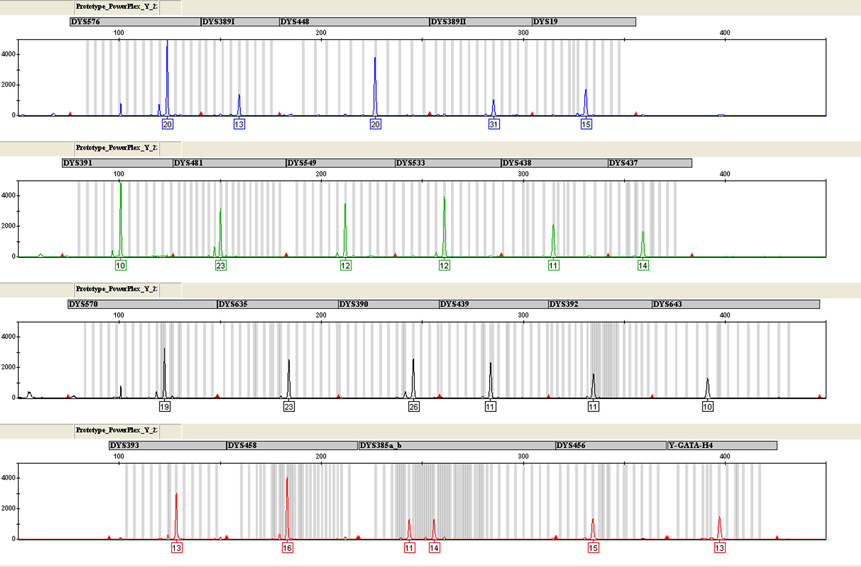The Use of PowerPlex® Y23 System with the ABI PRISM® 310 Genetic Analyzer
Department of Anatomy, Pharmacology and Legal Medicine, University of Turin, Turin, Italy
Publication Date: 2012
Introduction
Over the last fifteen years, multiplex PCR typing of Y-chromosomal short tandem repeat (STR) loci has emerged as a powerful tool for forensic casework analysis, especially in sexual assault cases, where evidence typically consists of mixtures containing large amounts of female DNA in the presence of minor amounts of male DNA. However, since Y-STR loci are from nonrecombining portion of the Y chromosome, individuals from the same lineage typically share the same profile. Therefore, Y-STR profiles do not carry the same discrimination power as autosomal profiles. The availability of new multiplex PCR assays that allow simultaneous typing of conventional and additional Y-STRs improves the power of discrimination of paternal lineages and is therefore highly welcomed by the forensic community. Recently Promega launched the PowerPlex® Y23 System, which includes the Y-STR loci found in the AmpFlSTR® Yfiler® PCR Amplification Kit from Life Technologies plus six new loci that display high genetic diversity in human populations. Two of the loci, DYS570 and DYS576, are rapidly mutating loci (1) .
The PowerPlex® Y23 System Technical Manual TMD035 describes instrument setup and sample preparation of PCR products using the ABI PRISM® 3100 and 3100-Avant Genetic Analyzers and Applied Biosystems 3130, 3130xl, 3500 and 3500xL Genetic Analyzers. Here, we report the successful analysis of amplicons obtained with PowerPlex® Y23 on the ABI PRISM® 310 Genetic Analyzer. We performed sensitivity and mixture studies using control DNA samples and compared typing results in a limited set of casework samples previously typed with the Yfiler® kit.
Materials and Methods
Sample preparation: For the sensitivity study, serial dilutions (1/40, 1/80, 1/160, 1/320, 1/640) of a male control DNA sample (10ng/μl) were prepared. For the mixture study, the five serial dilutions of male DNA were mixed 1:1 with a female control DNA sample (200ng/μl). Additionally, five serial dilutions (undiluted, 1/2, 1/4, 1/8, 1/40) of female control DNA (200ng/μl) were mixed 1:1 with male control DNA (0.25ng/μl).
Casework samples consisted of four mixed stains from sexual assault cases: the male/female DNA ratio ranged from 1:2 to 1:100, whereas the concentration of male DNA ranged from 0.1 to 2ng/μl. DNA quantitation was performed with Quantifiler® Human and Quantifiler® Y DNA quantification kits (Applied Biosystems).
PCR amplification: From the prepared dilutions and mixtures, 2μl (sensitivity study) or 4µl (mixture study) was amplified as described in the PowerPlex® Y23 System Technical Manual TMD035 using a GeneAmp® PCR System 9700 thermal cycler (Applied Biosystems). PCR input volumes for casework samples were adjusted to add 0.5ng of male template DNA to each reaction. Two PCR replicates were conducted for each sample.
Capillary electrophoresis: Amplicons (1μl) were run in the presence of 24μl of Hi-Di™ formamide (Applied Biosystems) and 1μl of CC5 Internal Lane Standard 500 using the module GS STR POP4 (1ml) G5. Electrophoresis conditions are as indicated below:
| Injection time | 5 seconds |
| Injection voltage | 15.0kV |
| Run voltage | 15.0kV |
| Run temperature | 60°C |
| Run time | 28 minutes |
For data analysis, a matrix file was generated as described in the PowerPlex® 5-Dye Matrix Standards, 310 Technical Bulletin TBD023. Genotyping was performed with the GeneMapper® ID software, version 3.2, (Applied Biosystems) using the provided panels and bins files.
Results
Results of the sensitivity study are shown in Figure 1. Full profiles (allele peaks >50RFU) were obtained at 62.5pg of template DNA; partial profiles could be observed even at 31.25pg of template DNA.
 Figure 1. Sensitivity study of PowerPlex® Y23 System on the ABI PRISM® 310 Genetic Analyzer. For each electropherogram the male template DNA amount per PCR is indicated.
Figure 1. Sensitivity study of PowerPlex® Y23 System on the ABI PRISM® 310 Genetic Analyzer. For each electropherogram the male template DNA amount per PCR is indicated.Results of the mixture study are shown in Figure 2. As seen in the electropherogram, the presence of excess female DNA at ratios as high as M:F 1:12,800 affected neither the specificity nor the sensitivity of the assay. Full profiles were observed at 62.5pg of template DNA and partial profiles at 31.25pg.
 Figure 2. Mixture study of PowerPlex® Y23 System on the ABI PRISM® 310 Genetic Analyzer. For each electropherogram the male template DNA amount per PCR and the ratio between male (M) and female (F) DNA are indicated.
Figure 2. Mixture study of PowerPlex® Y23 System on the ABI PRISM® 310 Genetic Analyzer. For each electropherogram the male template DNA amount per PCR and the ratio between male (M) and female (F) DNA are indicated.Finally, all of the tested casework samples generated full profiles (Figure 3). Genotypes were consistent with those previously obtained with the Yfiler® kit.
 Figure 3. Representative electropherogram of a sexual assault sample analyzed using the PowerPlex® Y23 System on the ABI PRISM® 310 Genetic Analyzer. DNA was purified from a vaginal swab with semen, and 0.5ng of template male DNA was amplified. The M:F DNA ratio was 1:100.
Figure 3. Representative electropherogram of a sexual assault sample analyzed using the PowerPlex® Y23 System on the ABI PRISM® 310 Genetic Analyzer. DNA was purified from a vaginal swab with semen, and 0.5ng of template male DNA was amplified. The M:F DNA ratio was 1:100.Conclusions
Our results show that the PowerPlex® Y23 System, though devised for medium- to high-throughput capillary electrophoresis instruments like the ABI PRISM® 3100 and 3100-Avant Genetic Analyzers and Applied Biosystems® 3130, 3130xl, 3500 and 3500xL platforms, is also compatible with “older” (yet widely used in forensic DNA laboratories) platforms such as the ABI PRISM® 310 Genetic Analyzer.
Related Products
Article References
- Vermeulen, M. et al. (2009) Improving global and regional resolution of male lineage differentiation by simple single-copy Y-chromosomal short tandem repeat polymorphisms. Forensic Sci. Int. Genet. 3, 205–13.
How to Cite This Article
Scientific Style and Format, 7th edition, 2006
Pasino, S., Caratti, S. and Robino, C. The Use of PowerPlex® Y23 System with the ABI PRISM® 310 Genetic Analyzer. [Internet] 2012. [cited: year, month, date]. Available from: https://www.promega.com/resources/profiles-in-dna/2012/the-use-of-powerplex-y23-system-with-the-abi-prism-310-genetic-analyzer/
American Medical Association, Manual of Style, 10th edition, 2007
Pasino, S., Caratti, S. and Robino, C. The Use of PowerPlex® Y23 System with the ABI PRISM® 310 Genetic Analyzer. Promega Corporation Web site. https://www.promega.com/resources/profiles-in-dna/2012/the-use-of-powerplex-y23-system-with-the-abi-prism-310-genetic-analyzer/ Updated 2012. Accessed Month Day, Year.
Contribution of an article to Profiles in DNA does not constitute an endorsement of Promega products.
PowerPlex is a registered trademark of Promega Corporation.
ABI PRISM, AmpFlSTR, Quantifiler and Yfiler are registered trademarks of Applera Corporation. GeneAmp is a registered trademark of Roche Molecular Systems, Inc. GeneMapper is a registered trademark of Applied Biosystems. Hi-Di is a trademark of Applera Corporation.